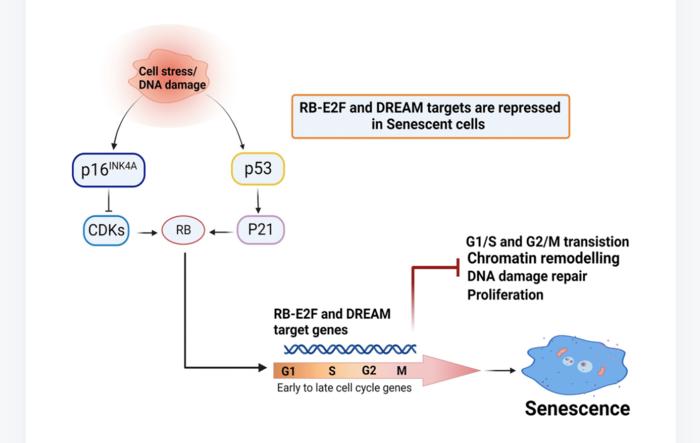“Our study enables us to envisage a global picture of genes and pathways dysregulated during senescence and provides novel evidence for involvement of p53/p16/RB-E2F-DREAM repressional targets in this complex cellular process.”

Credit: 2023 Kandhaya-Pillai et al.
“Our study enables us to envisage a global picture of genes and pathways dysregulated during senescence and provides novel evidence for involvement of p53/p16/RB-E2F-DREAM repressional targets in this complex cellular process.”
BUFFALO, NY- June 13, 2023 – A new research paper was published in Aging (listed by MEDLINE/PubMed as “Aging (Albany NY)” and “Aging-US” by Web of Science) Volume 15, Issue 10, entitled, “Key elements of cellular senescence involve transcriptional repression of mitotic and DNA repair genes through the p53-p16/RB-E2F-DREAM complex.”
Cellular senescence is a dynamic stress response process that contributes to aging. From initiation to maintenance, senescent cells continuously undergo complex molecular changes and develop an altered transcriptome. Understanding how the molecular architecture of these cells evolve to sustain their non-proliferative state will open new therapeutic avenues to alleviate or delay the consequences of aging.
In this new study, seeking to understand these molecular changes, researchers Renuka Kandhaya-Pillai, Francesc Miro-Mur, Jaume Alijotas-Reig, Tamar Tchkonia, Simo Schwartz, James L. Kirkland, and Junko Oshima from the University of Washington, Vall d’Hebron Research Institute (VHIR), Vall d’Hebron Hospital, and the Mayo Clinic studied the transcriptomic profiles of endothelial replication-induced senescence and senescence induced by the inflammatory cytokine, TNF-α. The researchers previously reported gene expressional pattern, pathways, and the mechanisms associated with upregulated genes during TNF-α induced senescence.
“Here, we extend our work and find downregulated gene signatures of both replicative and TNF-α senescence were highly overlapped, involving the decreased expression of several genes associated with cell cycle regulation, DNA replication, recombination, repair, chromatin structure, cellular assembly, and organization.”
The team identified multiple targets of p53/p16-RB-E2F-DREAM that are essential for proliferation, mitotic progression, resolving DNA damage, maintaining chromatin integrity, and DNA synthesis that were repressed in senescent cells. They show that repression of multiple target genes in the p53/p16-RB-E2F-DREAM pathway collectively contributes to the stability of the senescent arrest. Their findings show that the regulatory connection between DREAM and cellular senescence may play a potential role in the aging process.
“This study suggests that the transcriptome signature of senescent cells goes beyond cell cycle arrest, with expression of multiple genes, from cell cycle to DNA repair to chromatin structure, being coordinately repressed to stably lock cells into this essentially non-proliferative state.”
Read the full study: DOI: https://doi.org/10.18632/aging.204743
Corresponding Author: Renuka Kandhaya-Pillai
Corresponding Email: [email protected]
Keywords: cellular senescence, cell cycle, DREAM complex, DNA repair
Sign up for free Altmetric alerts about this article: https://aging.altmetric.com/details/email_updates?id=10.18632%2Faging.204743
About Aging-US:
Launched in 2009, Aging publishes papers of general interest and biological significance in all fields of aging research and age-related diseases, including cancer—and now, with a special focus on COVID-19 vulnerability as an age-dependent syndrome. Topics in Aging go beyond traditional gerontology, including, but not limited to, cellular and molecular biology, human age-related diseases, pathology in model organisms, signal transduction pathways (e.g., p53, sirtuins, and PI-3K/AKT/mTOR, among others), and approaches to modulating these signaling pathways.
Please visit our website at www.Aging-US.com and connect with us:
- SoundCloud
- YouTube
- LabTube
Click here to subscribe to Aging publication updates.
For media inquiries, please contact [email protected].
Aging (Aging-US) Journal Office
6666 E. Quaker Str., Suite 1B
Orchard Park, NY 14127
Phone: 1-800-922-0957, option 1
###
Journal
Aging-US
DOI
10.18632/aging.204743
Method of Research
Experimental study
Subject of Research
Cells
Article Title
Key elements of cellular senescence involve transcriptional repression of mitotic and DNA repair genes through the p53-p16/RB-E2F-DREAM complex
Article Publication Date
22-May-2023




